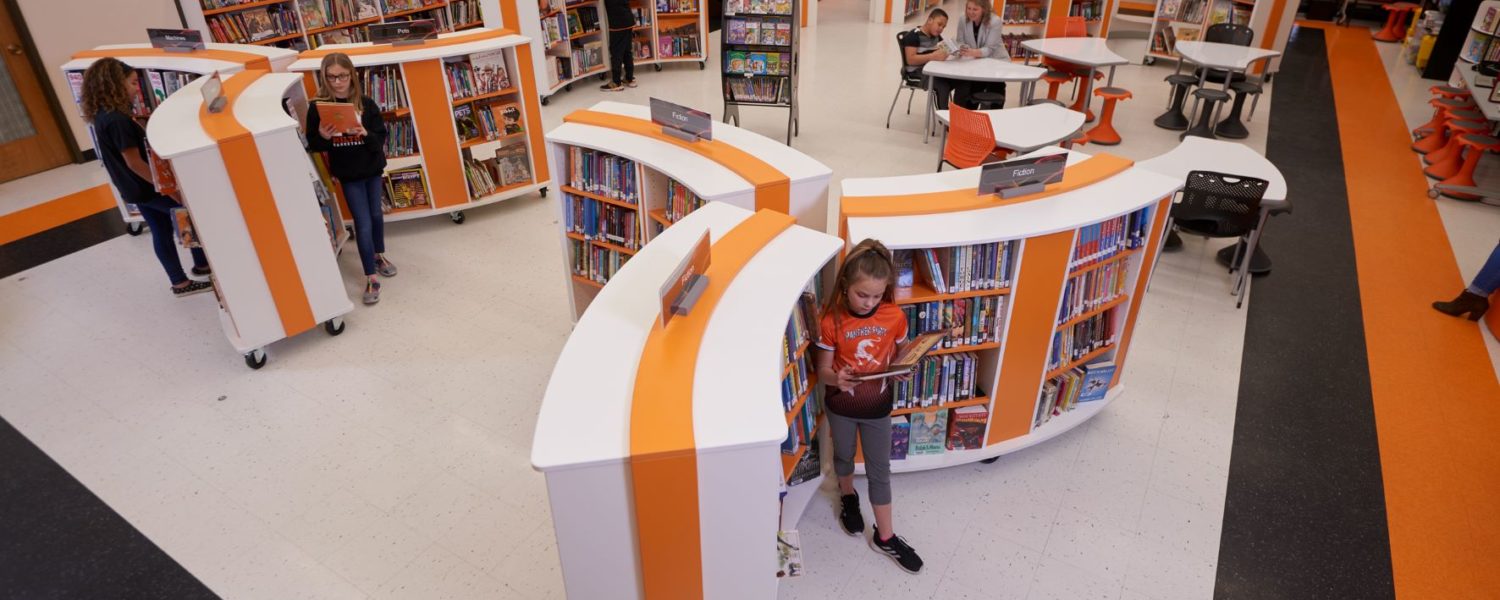By Jolie Conahan
Students that read for pleasure are much more likely to do well academically. What is it, though, that motivates students to pick up a new book and read it for pleasure? Take a journey in your student’s shoes. What do they see when they enter the library, and does that view send a positive message about reading?
This article will guide you through some key project planning and design principles that will ensure that you are developing a physical library space that guides students on a path of discovery and exciting new reading choices!
Make Books the Focal Point
The shelving product and layout you choose is the single biggest influencer of the way your updated physical space will function. Be strategic in the placement of bookcases so that books are always in the eyeline. This could mean turning existing bookcases or spacing them further apart so that students have room to browse comfortably.
If it’s currently unpleasant for multiple students to browse in one section together, focus on this as an area to revamp. Consider non-traditional shelving shapes like curves to create clearer sightlines to the book offering and more comfortable browsing experiences. Curved shelving also lends itself to easy zoning of spaces for different age groups or activities.
Creating these zones allows the library to function traditionally but creates natural paths for exploration within the space. The boundaries between zones become suggested instead of hard barriers like walls or partitions. Allowing students to move more freely and follow the organic pathways as they search for a book will create an emotional shift in the library experience. Be sure that books are in sight at every pivot.
Rotate Featured Collections
“Flexible, Mobile and Modular” are hot-button words in the furniture industry right now, but how do these traits impact your young readers? Use mobile bookcases or modular displays to shake up the library browsing experience for students. Move an entire mobile bookcase with popular titles and relocate it to a less prominent spot that requires more exploration to get to. Students will find something new along the way! Move lesser circulated genres like poetry or biography to locations where students might typically find their favorite series books.
Choosing a good mix of mobile or modular bookcases and displays with flexible tables and seating options will allow for endless opportunities to rearrange your people flow to offer new reading experiences, plus support requirements for ADA compliance, social distancing, library events and more.
Offer Choices of Where to Sit for Independent Reading
It’s easy to get excited about adding new colorful soft seating or lounge options – but do make sure that those elements relate spatially to books themselves. Plan independent reading spaces by adding interesting soft seating options within an arm’s reach of the bookshelves or free-standing displays. This makes it natural for even a reluctant reader to find a seat and reach out to grab a new book to try.
You can be very deliberate in your placement of attractive modular seating options in relation to less visited collections to which you might want to bring more exposure. Selecting a handful of non-traditional reading seats with “wow” factor is sure to raise the status of reading for pleasure!
Make Books Easy to See, Touch and Take
Eye level is buy level. This is an old retail rule, but it holds true even in education settings. Retail research shows that products placed comfortably at eye level in front of browsing customers are more likely to become purchases. This is an especially important element in designing for emergent readers.
Be sure to right-size bookcases and displays to your “customer” and to the specific medium you are displaying for the most visual impact. Choose display options that turn exciting book cover graphics face out to the browser, and be sure to train all library staff to keep those displays full, vibrant, and professional, while keeping hand-made signs and displays that detract from the book covers and create visual clutter to a minimum.
Dream Big and Remember the Goal
Kicking off a library update can be overwhelming. Dream big and develop a full, visual roadmap for the furniture and design changes you’ll need to make to raise the status of reading among your students.
Gaining support from your administrators and the school community will be difficult without a well-presented plan, so partner with a design firm or furniture vendor that can offer expertise in the planning phase. Lots of firms do this for free!
Keep that big dream plan pinned in a prominent spot and resist the urge to add features to the library that don’t support your goal of creating excitement about reading.
Jolie Conahan is the director of sales and marketing for Opening the Book North America, a library furniture manufacturer and designer specializing in school and public libraries across the United States and Canada, www.openingthebookUS.com.









